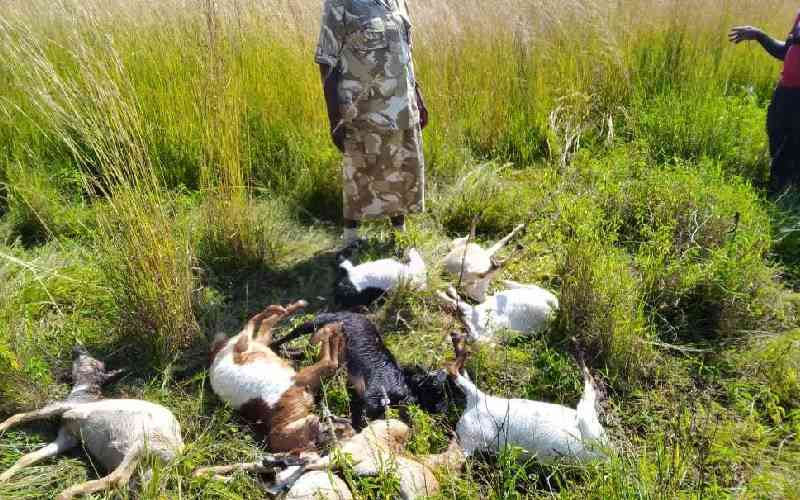By Mahanda Indakwa
Tucked in a corner of a local newspaper was a story headlined: “British paratroopers to train Kenyan rangers to fight poachers.”
Why Kenya Defence Forces, whose paratroopers understand this terrain better than foreigners, is not training game rangers 50 years after independence should cause Kenyans to ask themselves a few hard questions.
First, and this is has been the subject of intense debate in wildlife circles for decades, who owns our wildlife? Second, does Kenya really care about its wildlife or “wildlife is our national heritage” is mere sloganeering and hot air? Third, is our fixation with poaching strategic when evidence suggests habitat loss and human-wildlife conflict are the major wildlife conservation challenges? And finally, can we, with certainty, claim that we will have wildlife in the next 50 years? But first, a look at history:
When the colonial government set up the then East African Protectorate in 1895, rape of Kenya’s wildlife resources was going on in earnest. Arab ivory traders had been slaughtering elephants for their tusks for hundreds of years. Europeans, meanwhile, were hunting big game for sport at catastrophic rates.
Opened hinterland
The East African Railway from Mombasa to Kisumu opened the hinterland even further, meaning more wildlife could be killed faster, both for sport and to eradicate ‘vermin’ — the dangerous wild animals that stood in the way of colonial farmers creating empires out of the so-called white highlands. In Makueni alone, 999 black rhinos, today an acutely endangered species, were exterminated between 1945 and 1946 to create space for agricultural settlement.
Ironically, the colonial government became alive to the threat of wildlife extinction quite early, carving out two gigantic conservation areas, North and Southern Reserve, by 1900. In 1946, Nairobi National Park — the first of nearly 65 parks, game reserves and wildlife sanctuaries today — was established as a protected area where hunting and other human activities were banned. But these protectionist tendencies were at odds with the Government’s own Game Department, which made loads of money licensing sport hunters and shooting animals. Indeed, pioneer game wardens, most former sport hunters, were allocated hunting quotas to shoot animals and sell wildlife trophies to supplement their meagre salaries. Buried within this history lies the origin of the modern day Kenyan’s laissez faire attitude towards wildlife and conservation.
In a 2012 paper titled, The Kenya Wildlife Service in the 21stCentury: Protecting Globally Significant Areas and Resources, wildlife ecologist Dr John Waithaka argues that the British colonialists’ approach to land acquisition, establishment of national parks and game reserves and their relationship and attitude toward African people and their cultures played a crucial role in shaping the attitude of many Kenyans towards wildlife. In fact, it continues to have a bearing on how conservation issues are perceived and tackled today, he says.
Parks and game reserves were curved out of community lands without consulting the locals. Africans, who mostly revered the environment and hunted for the pot at a rate that could not compare to the wasteful slaughter of thousands of ‘vermin’ or as sporting targets by whites, were deemed poachers and hunted down mercilessly. The Waliangulu of Tsavo area, fierce elephant hunters dubbed ‘people of the long bow’, were forced to ‘mend their ways’, ironically by game wardens who bumped off a few elephants annually to supplement their incomes.
Locals could not graze their cattle or collect firewood or herbal medicines on parkland their forefathers had owned for generations. And no one bothered to explain why.
Became a plaything
Wildlife became a plaything for former white hunters who ‘loved animals’, unlike African ‘poachers’ who were hell bent on turning hares and squirrels into stew. It is doubtful whether ‘natives’ were welcome to the parks as tourists, but they did not own cars anyway and even so, ogling at wild creatures for fun has never been an African past time.
But it would be absurd to blame colonialists for the problems bedeviling the wildlife sub-sector today — 50 long years after independence. In fact, pioneer white game wardens, many of them barely literate former soldiers lacking in wildlife management experience, must be lauded. They curved parks out of harsh African bush land, in the remotest of places, establishing a park management system that not only remains functional today but also is hailed as one of the most advanced in Africa. They built offices, park roads and water pans, kept diaries, carried out rudimentary research, battled poachers, wrote books and experimented, grappling with ecological problems they could hardly comprehend because wildlife ecology is a relatively young science.
Their successors, our own African wardens who are much better educated and exposed, hardly kept (and still don’t keep) diaries, wrote books or experimented. In fact, I know of only one game warden, a Mr Daniel Nyeki, who has published a book titled Wildlife Conservation and Tourism in Kenya. Of course Dr Richard Leakey and Dr David Western, both Kenyans of white ancestry and former directors of KWS, have written biographies. But it is instructive that their books were published overseas for the international audience, are probably not stocked in our bookshops or universities and only a handful of our current crop of wardens have read them.
Stay informed. Subscribe to our newsletter
Thus, many years after independence, European nationals and residents remain more concerned about the plight of our wildlife than our own leaders. Old English and American women contribute financially for conservation efforts in Kenya, yet highly educated Kenyans would grab protected land and turn it into cabbage farms at the slightest opportunity (a former provincial commissioner hived a chunk off Kakamega Forest for a cane farm). The mwananchi, meanwhile, considers wildlife a ‘KWS and mzungu thing’ even as we plead with foreigners to visit our parks, in the face of a huge and moneyed local middle class. We have simply never owned wildlife, preferring to leave matters to a nebulous thing called government, one that has for years left our so-called national heritage to the whims of donors and NGOs.
Looming trouble
The decline, as with many things Kenyan, began at independence. Initially, wildlife was managed through two departments — the Wildlife Conservation and Management Department responsible for control of wildlife outside parks and Kenya National Parks. When these two departments were merged in 1976, trouble loomed. Writing in www.dswtwildernessjournal.com, Dame Daphne Sheldrick says, “The new Government Wildlife Conservation and Management Department very soon earned the title of ‘The Wildlife Poaching and Mis-Management Department’. Then followed three decades of wholesale in-house slaughter of elephants and rhino for ivory and horn perpetrated by Somali shifta armed with automatic rifles, and also by the wardens and rangers and well-connected individuals.”
Poaching became a massive organised crime syndicate, abated by the political elite who were minting millions from sale of ivory and game trophies. It is these powerful people that perhaps prevented Dr Perez Olindo, the first African wildlife conservation chief, from cracking hard on the poachers within the ranks.
With minimal financial support from the Government, the organisation went to seed. Vehicles and earth moving equipment were grounded. Poaching was so rampant that parks were literally stinking of rotting flesh. Such was the level of impunity that poachers had the audacity to attack the Meru National Park headquarters and kill one of the park’s two surviving rhinos moved there ostensibly for protection. A local and international outcry led by director of the National Museum Dr Richard Leakey ensued, forcing President Daniel arap Moi to disband the tattered outfit and replace it with the Kenya Wildlife Service (KWS), with Leakey as founding director.
In his Wildlife Wars, Dr Leakey describes a department riddled with corruption where many rangers and wardens were making a kill shooting elephants for ivory — perhaps in cahoots with senior people in Government. So dire was lack of resources that rangers did not have boots, he says.
A man without a university education but a big thinker and speaker with international credentials and single-minded ruthlessness, he built KWS from scratch. Firing the corrupt and retrenching dead wood, he fundraised, rehabilitated vehicles and aircraft and took the war to poachers while building a spanking new headquarters. Notably, it was his wingman Omar Bashir, formerly deputy GSU commandant and a firm disciplinarian, who now as Deputy KWS Director in Charge of Security, whipped together a crack new anti-poaching unit — better armed, kitted, trained, and paid — that made short work of poachers.
Dr Leakey’s greatest contribution is lobbying the world, through the Convention on International Trade in Endangered Species, to ban trade in elephant ivory and rhino horn — a feat he achieved after convincing President Moi to burn 12 tonnes of ivory in Nairobi National Park. It is Leakey who made the world aware that elephant and rhino extinction was a distinct reality in our lifetime given the unprecedented levels of poaching.
Leakey, who lost both legs in an aircraft crash and received numerous death threats from poachers, was, however, hounded out of KWS amid allegations of ‘tribalism, equipping rangers better than the army and paying astronomical salaries to select individuals’.
But the world-renowned anthropologist has been quoted saying his removal was based on cheap politics, that he was being fought by corrupt and powerful individuals who wanted a piece of the colossal amounts of money he had raised from foreign donors. Some observers, however, say Leakey simply become too powerful, and his bid to take over Maasai Mara National Game Reserve, managed by the powerful Narok County Council, was the last straw.
 The Standard Group Plc is a
multi-media organization with investments in media platforms spanning newspaper
print operations, television, radio broadcasting, digital and online services. The
Standard Group is recognized as a leading multi-media house in Kenya with a key
influence in matters of national and international interest.
The Standard Group Plc is a
multi-media organization with investments in media platforms spanning newspaper
print operations, television, radio broadcasting, digital and online services. The
Standard Group is recognized as a leading multi-media house in Kenya with a key
influence in matters of national and international interest.
 The Standard Group Plc is a
multi-media organization with investments in media platforms spanning newspaper
print operations, television, radio broadcasting, digital and online services. The
Standard Group is recognized as a leading multi-media house in Kenya with a key
influence in matters of national and international interest.
The Standard Group Plc is a
multi-media organization with investments in media platforms spanning newspaper
print operations, television, radio broadcasting, digital and online services. The
Standard Group is recognized as a leading multi-media house in Kenya with a key
influence in matters of national and international interest.









